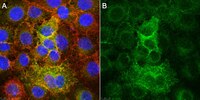MABC1637-100UG Sigma-AldrichAnti-xCT Antibody, clone 3A12
Anti-xCT, clone 3A12, Cat. No. MABC1637, is a rat monoclonal antibody that detects Cystine/glutamate transporter (xCT) and is tested for use in Immunocytochemistry and Western Blotting.
More>> Anti-xCT, clone 3A12, Cat. No. MABC1637, is a rat monoclonal antibody that detects Cystine/glutamate transporter (xCT) and is tested for use in Immunocytochemistry and Western Blotting. Less<<Recommended Products
Overview
| Replacement Information |
|---|
| References |
|---|
| Product Information | |
|---|---|
| Format | Purified |
| Presentation | Purified rat monoclonal antibody IgG2a in buffer containing 0.1 M Tris-Glycine (pH 7.4), 150 mM NaCl with 0.05% sodium azide. |
| Quality Level | MQ200 |
| Physicochemical Information |
|---|
| Dimensions |
|---|
| Materials Information |
|---|
| Toxicological Information |
|---|
| Safety Information according to GHS |
|---|
| Safety Information |
|---|
| Storage and Shipping Information | |
|---|---|
| Storage Conditions | Recommend storage at +2°C to +8°C. For long term storage antibodies can be kept at -20°C. Avoid repeated freeze-thaws. |
| Packaging Information | |
|---|---|
| Material Size | 100 μg |
| Transport Information |
|---|
| Supplemental Information |
|---|
| Specifications |
|---|
| Global Trade Item Number | |
|---|---|
| Catalog Number | GTIN |
| MABC1637-100UG | 04065266908251 |
Documentation
Anti-xCT Antibody, clone 3A12 Certificates of Analysis
| Title | Lot Number |
|---|---|
| Anti-xCT, clone 3A12 - Q3744983 | Q3744983 |








